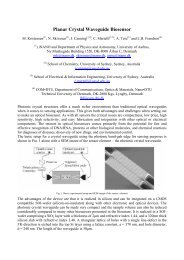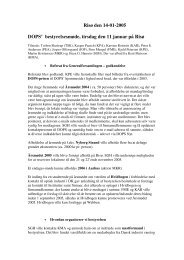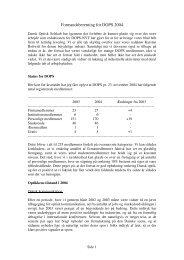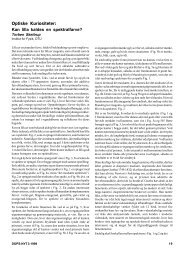3D display with floated integral imaging - DOPS - Danish Optical ...
3D display with floated integral imaging - DOPS - Danish Optical ...
3D display with floated integral imaging - DOPS - Danish Optical ...
You also want an ePaper? Increase the reach of your titles
YUMPU automatically turns print PDFs into web optimized ePapers that Google loves.
SPIE Newsroom<br />
10.1117/2.1200702.0547<br />
<strong>3D</strong> <strong>display</strong> <strong>with</strong> <strong>floated</strong> <strong>integral</strong><br />
<strong>imaging</strong><br />
Byoungho Lee, Joohwan Kim, and Sung-Wook Min<br />
Floating <strong>display</strong> and <strong>integral</strong> <strong>imaging</strong> technologies can be combined to<br />
produce <strong>3D</strong> images for unaided viewing at close range.<br />
With flat-panel <strong>display</strong> technologies approaching saturation,<br />
prospects for <strong>3D</strong> techniques are currently attracting much industry<br />
attention. We suggest a new system for generating images<br />
that appear three-dimensional to viewers <strong>with</strong>out the need for<br />
special glasses.<br />
Our system combines two <strong>3D</strong> <strong>display</strong> techniques: <strong>integral</strong><br />
<strong>imaging</strong> and floating <strong>display</strong>. 1–3 An <strong>integral</strong> <strong>imaging</strong> system<br />
consists of a two-dimensional (2D) lens array and <strong>display</strong> system.<br />
An elemental image on a 2D panel gives a different perspective<br />
to each elemental lens, as shown in Figure 1. The lens<br />
array integrates the elemental images to form a <strong>3D</strong> image <strong>with</strong><br />
full parallax and an almost continuous view.<br />
However, due to the lens law, <strong>integral</strong> <strong>imaging</strong> provides good<br />
quality <strong>3D</strong> only around an image plane that delivers a focused<br />
image. If the separation between the lens array and <strong>display</strong> plane<br />
is equal to the focal length of the lens array, the image plane can<br />
be located at infinity. In this case, a <strong>3D</strong> image may be formed at<br />
any location, but <strong>with</strong> poor resolution. Hence, <strong>with</strong> the <strong>display</strong> at<br />
a distance, a method is needed to bring the <strong>3D</strong> integrated image<br />
closer <strong>with</strong>out sacrificing quality.<br />
A floating <strong>display</strong> would be one solution. This <strong>3D</strong> technique,<br />
frequently used in exhibitions and magic shows, employs a convex<br />
lens (also known as a floating lens) or concave mirror to form<br />
a realistic image close to the observer. This technology typically<br />
uses 2D images for dynamic image-floating systems. Our proposed<br />
system uses a convex lens to move a <strong>3D</strong> image constructed<br />
by <strong>integral</strong> <strong>imaging</strong> into the vicinity of the observer, as depicted<br />
in Figure 2.<br />
Important parameters for such a system include the viewing<br />
window, viewing angle, and expressible depth range. Angle and<br />
expressible depth range are related to image parameters while<br />
the window is a unique <strong>display</strong> characteristic in this system. It<br />
is a 2D area through which <strong>3D</strong> images, undistorted or unbro-<br />
Figure 1. The concept of <strong>integral</strong> <strong>imaging</strong>.<br />
ken, can be observed. This is explained by the fact that parallel<br />
rays refracted by a convex lens converge at its focal plane.<br />
Moreover, the point of convergence is farther from the principal<br />
axis because the rays are steeper before refraction. We can<br />
thus conclude that the position of the viewing window is at the<br />
focal plane, and its border will be made up of by the convergent<br />
points of the rays forming the viewing angle of the <strong>integral</strong><br />
<strong>imaging</strong> system. We have discussed and analyzed this system in<br />
detail elsewhere. 2<br />
We have implemented an <strong>integral</strong> floating <strong>display</strong> using a<br />
floating lens <strong>with</strong> a focal length of 175mm. The <strong>integral</strong> <strong>imaging</strong><br />
system had a viewing angle of 32 ◦ and the lens array was<br />
comprised of 13 × 13 lenses <strong>with</strong> focal lengths of 22mm. We calculated<br />
the size of the viewing window to be 101mm × 101mm,<br />
while the viewing angle was 14 ◦ <strong>with</strong> an expressible depth range<br />
of 19mm. Figure 3 shows the experimental results.<br />
Continued on next page
10.1117/2.1200702.0547 Page 2/2<br />
SPIE Newsroom<br />
Byoungho Lee received his PhD in electrical engineering and<br />
computer science from the University of California at Berkeley<br />
in 1993 . Since 1994 he has been <strong>with</strong> Seoul National University,<br />
where he is currently a full professor. He has authored or<br />
coauthored more than 180 papers in international journals and<br />
presented more than 290 international conference papers. He is<br />
a fellow of SPIE and OSA, and has served as a member for the<br />
Engineering, Science and Technology Policy (ESTeP) Committee<br />
of SPIE.<br />
References<br />
1. S. -W. Min, M. Hahn, J. Kim, and B. Lee, “Three-dimensional electro-floating<br />
<strong>display</strong> system using an <strong>integral</strong> <strong>imaging</strong> method,” Optics Express 13(12), pp. 4358–<br />
4369, 2005.<br />
2. B. Lee, J. Kim, and S. -W. Min, “Integral floating 3d <strong>display</strong> system: principle<br />
and analysis,” Three-Dimensional TV, Video, and Display V, Optics East, Boston, MA,<br />
USA, Proc. SPIE 6392-18, 2006.<br />
3. J. -H. Park, S. -W. Min, S. Jung, and B. Lee, “Analysis of viewing parameters<br />
for two <strong>display</strong> methods based on <strong>integral</strong> photography,” Applied Optics 40(29),<br />
pp. 5217–5232, 2001.<br />
Figure 2. (a) The concept of the <strong>integral</strong> floating <strong>display</strong> and (b) its<br />
implementation.<br />
Figure 3. The experimental results. The left view was taken at an angle<br />
of 7 ◦ to the left and the right view at an angle of 7 ◦ to the right (viewing<br />
angle of 14 ◦ ). In the left and right views we placed white lines at<br />
the predicted borders of the viewing window, <strong>with</strong> the flipped images<br />
positioned such that they can be concealed if we block the area outside<br />
the window. The objects are constructed to be positioned inside the expressible<br />
depth-range to ensure that perspective and shape are of good<br />
quality.<br />
Author Information<br />
Byoungho Lee, Joohwan Kim and Sung-Wook Min<br />
School of Electrical Engineering<br />
Seoul National University<br />
Seoul, Korea<br />
http://oeqelab.snu.ac.kr<br />
c○ 2007 SPIE—The International Society for <strong>Optical</strong> Engineering


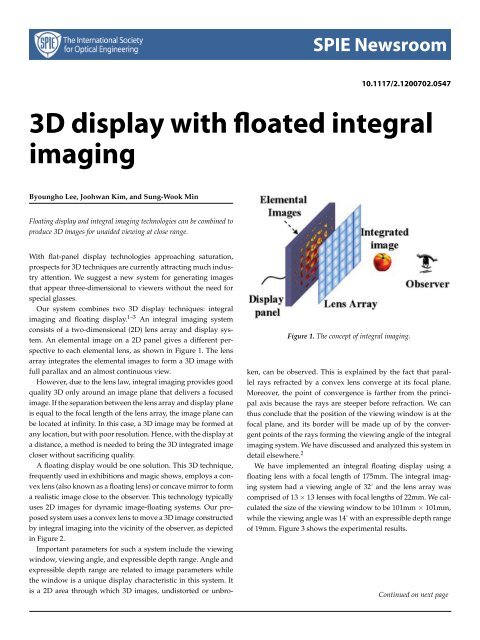

![DOPS General Assembly 2011 abstracts[2]](https://img.yumpu.com/26607591/1/184x260/dops-general-assembly-2011-abstracts2.jpg?quality=85)


